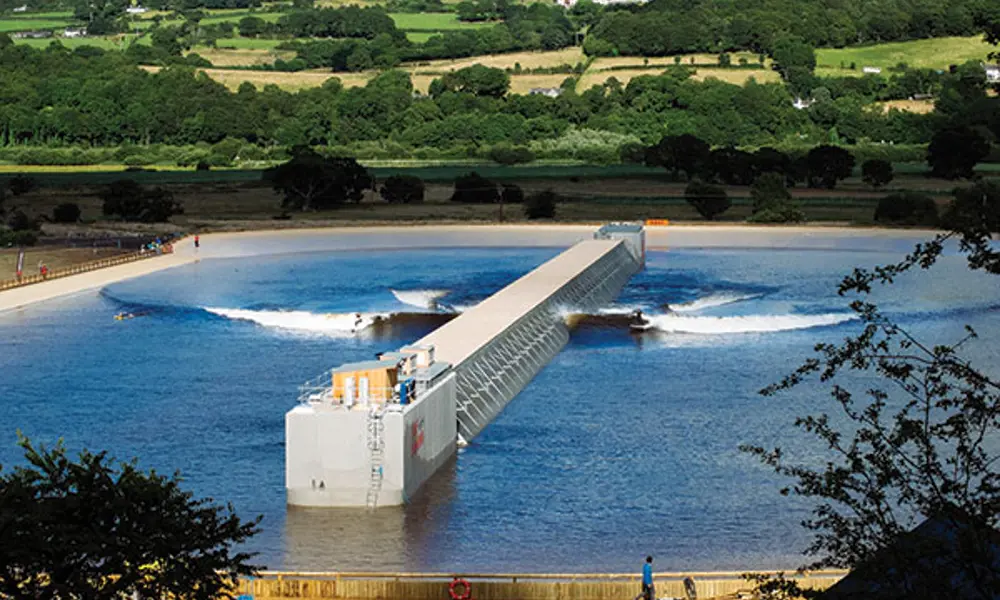
How to create the perfect wave
Man-made waves have been in evidence for more than a century. One of the first wave machines recorded was built in the 19th century by the wealthy King Ludwig of Bavaria, who created a grotto complete with artificial waves and a waterfall. Over the next 100 or so years, the ‘wave pool’ became more popular: one of the first modern water parks, Palisade Park in New Jersey, USA, opened in 1923 with a wave machine, and Big Surf, where surfers could ride artificial waves, followed soon after in 1969 in Arizona. A few years later in 1976, the first continuously breaking stationary wave was developed in Australia, and at the turn of the century, the first barrelling wave pool opened to the public in South Africa. For many years, waves have been created for entertainment and sporting endeavours across the world; while civil and marine engineers have used wavemaking and physical modelling to solve real problems for more than 70 years.
Types of waves
🌊 What are the different types of waves?
Breaking waves: formed when the wave collapses on top of itself. They are of two types:
- Plunging breaker where the wave reaches a steeper beach and curls, moving over a pocket of air while travelling very quickly.
- Spilling breaker where the wave reaches a sloping sandy beach, dispersing the energy over a large area.
Deep-water waves: made up of a number of waves of different lengths superimposed on each other. They are short-crested and multidimensional.
Destructive/plunging waves: high waves of short wavelength and a vertical ellipsis. When the wave breaks on a steep beach, the water plunges forward. Inshore waves: the length of these waves is less than the depth of the water they enter, which decreases their velocity. This decreases the wavelength and increases the height, eventually breaking the wave.
Progressive waves: these move with a steady speed, hence their name. There are two types of progressive waves:
- Capillary waves that are formed when wind creates pressure over capillarity, the binding force that holds the water molecules of the ocean surface together.
- Orbital progressive waves that are formed at the boundary of two liquids with different density.
Refracted waves: these travel in shallow water when they approach the shore. The shallowness decreases the power of the wave and causes a curve.
Seiche waves: caused by movement within a confined space, resulting in long wavelengths. These are significant in long water bodies such as Scottish lochs, and may materially contribute to extreme water levels, leading to flooding.
Shallow water waves: these move in shallow waters at a depth less than 1/20th of their wavelength. There are two kinds of these waves:
- Tidal waves that are formed by the gravitational pull of the sun and the moon on the ocean.
- Seismic sea waves/tsunami that are caused by earthquakes beneath the ocean. They travel extremely fast in open water, have significant height in shallow water, and are very dangerous and devastating.
Spilling/constructive waves: these have a long wavelength and low height. When they reach the shore, the ellipse becomes horizontal. When the wave breaks, the water reaches the upper part of the beach with little backwash.
Swell waves: these intense waves generate from a storm’s centre where the winds are strong. These expel little energy, travel long distances and break on distant shores.
Tidal technology
Waves are typically formed by wind blowing across water, with their size determined by the level of surface disturbance and the shape and features of the seabed. A shallowing of the seabed causes waves to steepen as they run up a beach, while a strong tidal current acting against them increases the waves’ height.
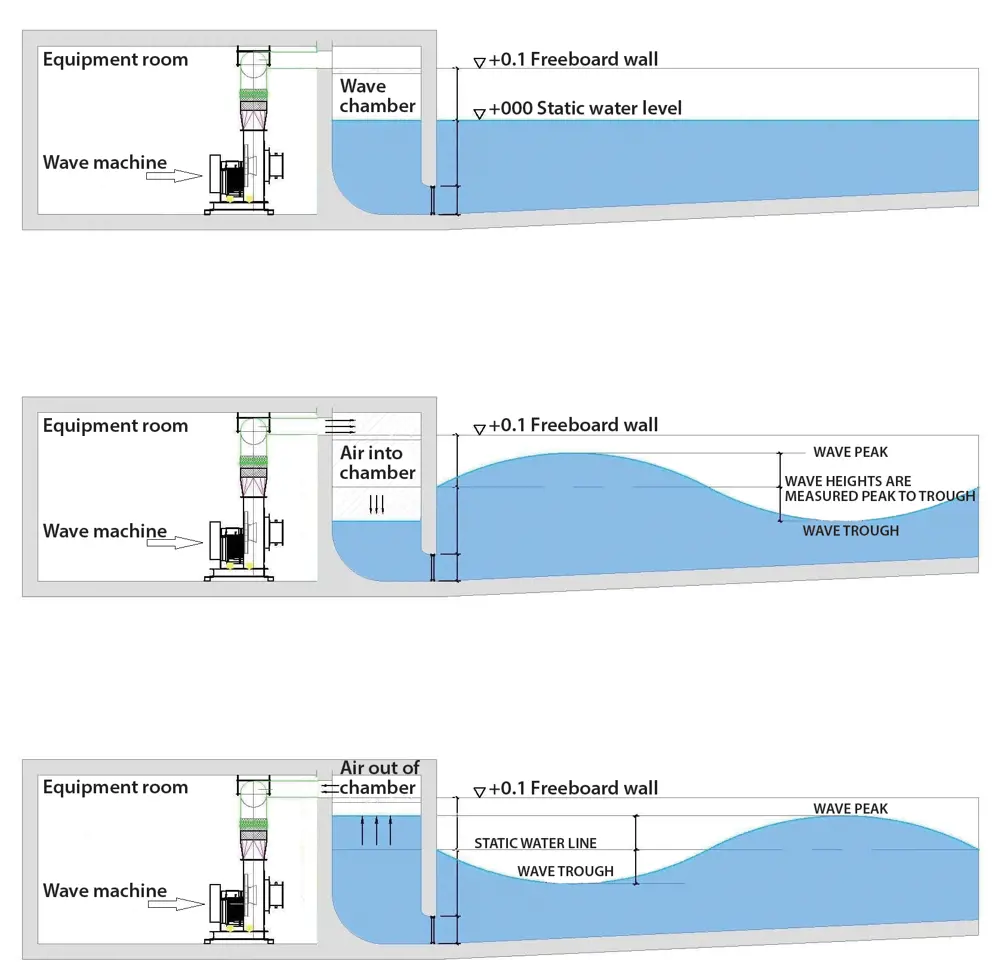
Principles of wave generation using a pneumatic system © Murphy’s Waves
Dr Sally Bennett, New Frontiers Fellow at the University of Southampton’s Faculty of Engineering and the Environment, explains that in the open ocean, sea states contain an infinite number of wave frequencies and amplitudes, making them random and difficult to replicate. When they are modelled, they are represented by a wave spectrum describing the energy present in a given sea.
Man-made marine waves are generated in three different ways. A flume is used to create shallow water conditions to test how waves break against a sea wall, for example, but for open conditions, a towing tank facility or wave basin is used. Many modern wave pool systems use the pneumatic wave-maker system that channels high volumes of forced air into closed chambers. Valves open to allow the forced air into the top of each chamber and this pushes the water out through grates and into the pool. When the airflow valve closes, the water flows back into the chamber.
In the open ocean, sea states contain an infinite number of wave frequencies and amplitudes, making them random and difficult to replicate
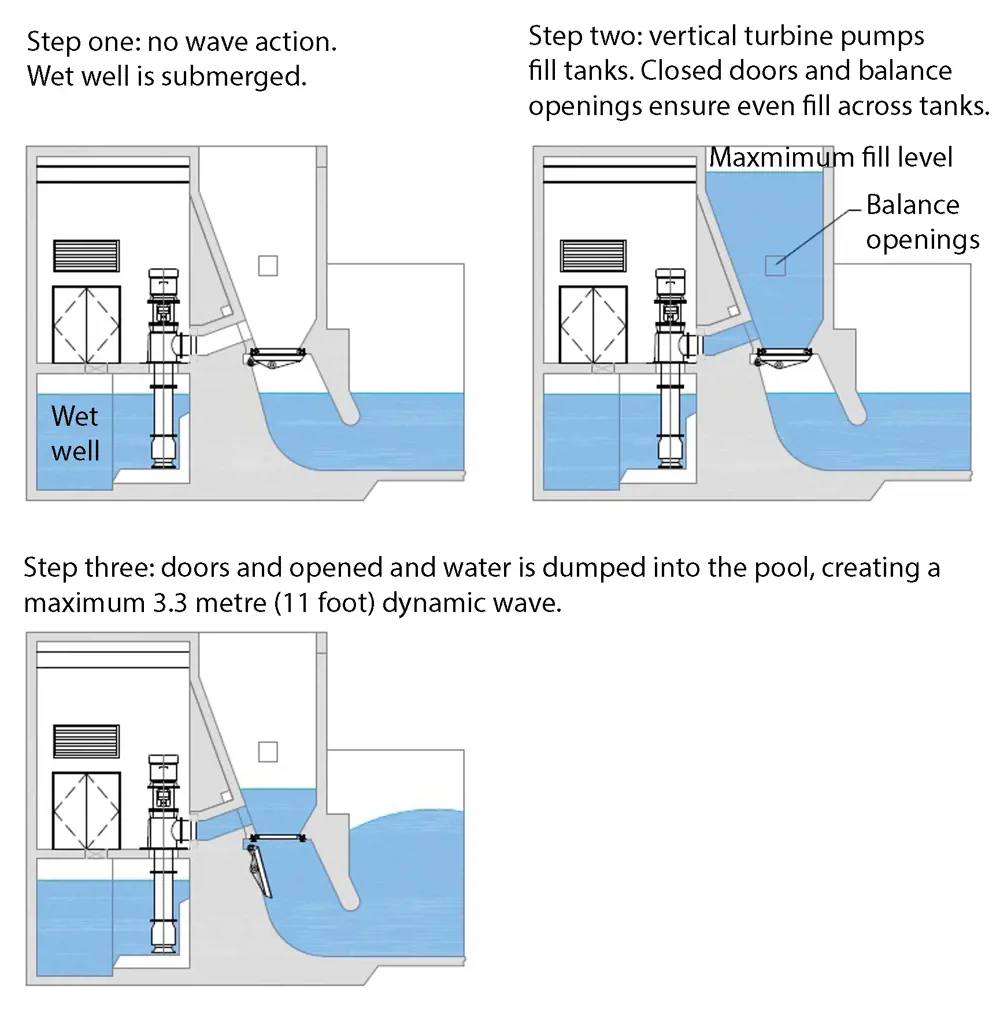
Principles of surfing wave generation © Murphy’s Waves
A towing tank facility traditionally consists of a long, relatively narrow tank that has a wave maker at one end and an absorption beach at the other to prevent waves reflecting back and interfering with the sea state being generated. The waves created travel in a unidirectional manner along the length of the tank, making the equipment useful for studying ship models or other marine structures.
The most sophisticated approach to mimicking real- life sea conditions is by using a wave basin that allows waves to be generated from all directions. Such tanks are rare because wave makers have to be installed on every side of the tank, but this means that individual paddles can move out of phase with each other and generate complex and fully representative seas from multiple directions, just like the real ocean.
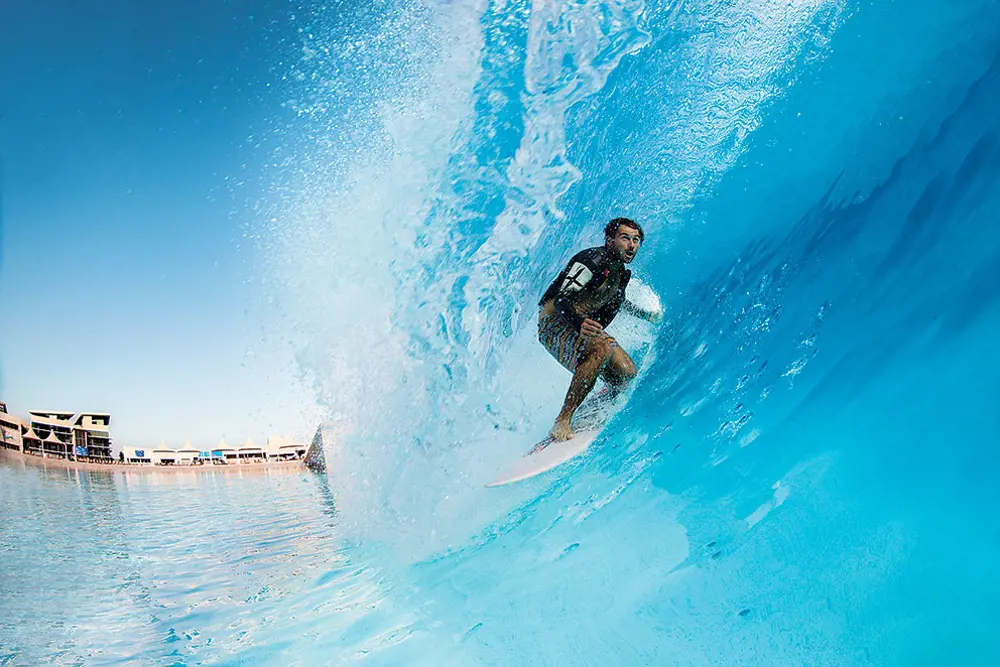
Ideal conditions for surfing include a light offshore wind that blows into the front of the wave, making it a barrel wave. The surface of the water needs to be smooth and the wave needs to break in one direction and not fold over in different places along its length; it is important that the wave starts to break continuously from one position so that a surfer can ride along its unbroken face. When the top of the wave starts to fold over and meet the sea, the gap between it that surfers often ride through is known as the barrel © Murphy’s Waves
Waves for fun
In the leisure market, scientific realism and controllability are less important in wave making. Surfing facilities generally require high standards of repeatability, and the wave maker must be particularly robust as it is expected that further improvements will be required to keep capital and operational costs down and reliability up. Leisure wave pools need reasonably realistic waves but it is much less important than simplicity and reliability of operation.
Jim Stuart, CEO of Glasgowbased Murphy’s Waves, explains that the principle behind the company’s Point Break Surf wave generator, which produces waves almost four metres high, is relatively simple. Pumps draw water from an underground reservoir to fill up a number of tanks (typically 10 for a 30-metrewide pool). The 100,000 litre tanks are filled in just 70 seconds and to create a large wave, a hydraulic system opens the tank gates to flood the pool with extra water. The shape of the wave is dictated by the pool’s ‘reef’ (specially shaped floor).
Waves become smaller thanks to the Y-shape of the pool at Siam Park in Tenerife, where the wave machine is installed, and excess water is bled off into an underground culvert. This water flows back into the underground reservoir, which holds enough water to generate four large waves, so that it can be pumped again and swimmers and surfers do not have to wait long between waves. The size of the wave is determined by how full with water the tanks are – the more water, the bigger the wave – and means that the waves can be modelled to be suitable for swimmers or surfers. Barrelling waves for surfing can also be created to run from left to right (or vice-versa) depending on the order that the water is released from the tanks.
The simplicity and reliability of these leisure waves are informed by extensive research. Surf Snowdonia in the Conwy Valley, the world’s first inland surf lagoon, was designed and created following a decade of R&D and feedback from hundreds of surfers on a test facility.
The size of the wave is determined by how full with water the tanks are – the more water, the bigger the wave – and means that the waves can be modelled to be suitable for swimmers or surfers
In order to replicate the type of waves experienced in the ocean, mechanical engineers at Wavegarden (the Spanish company behind Surf Snowdonia) used computational fluid dynamics (CFD) – a branch of fluid mechanics that uses numerical methods and algorithms to solve and analyse problems that involve fluid flows – to generate simulations of the height, length, shape and forces of breaking waves that would be suitable for a recreational lagoon. The data collected from CFD simulations allowed engineers to design the contour and undulating bathymetry (topography of the underwater floor) of the lagoon, which is responsible for how the waves form.
Unlike the tanks that are usually used to create waves, a swell is created in the lagoon using a wavefoil (similar to a snowplough) that moves at a speed of approximately six metres per second, shuttling underwater from one end of the 300-metre-long lagoon to the other. The energy of the swell interacts with the shallowing sections of the lagoon’s bed, causing it to build in size and steepen.
The wavefoil’s backwards and forwards motion is powered by a gearless ropeway drive system, which comprises a low-speed synchronous motor and an output shaft directly linked to a pulley wheel. The simple gear system, inspired by ski-lift technology, is capable of producing waves that hold their form and power over any distance. The waves are produced at the touch of a button as a fully automated control unit operates the drive system and wavefoil, while sensors on the wavefoil and drive system relay feedback in real time about the functioning of the system.
Safety measures include a ‘pier’ in the centre of the lagoon that protects surfers from moving parts of the wave-generating system and ‘dissipative shores’, pliable grid-like structures around the lagoon’s periphery that reduce currents after a wave passes. White-water flows up the gently sloped shores and drops into the grill to significantly reduce backwash, which is essential in ensuring wave quality.
the difficulty with circular wave pools is that the waves need to be generated in all directions
Within the leisure sector, the preferred wave machine is a circular wave pool. Wave pools are traditionally fan shaped with the beach at one end to dissipate waves, and while this is less expensive to design and construct, it restricts capacity. Circular pools enable higher capacity and more space around the edges for sunbathing areas and bars, which can be lucrative to businesses. Jim Stuart explains that the difficulty with circular wave pools is that the waves need to be generated in all directions.
Where usually waves are created using a pneumatic system that is a series of chambers in a line, in the round pool designed by Murphy’s Waves, a wave is generated from its centre by slowly rotating a shaped vane (hydrofoil) in the water. In much the same way that a propeller on a plane or boat is rotated – although much slower and with a different orientation – the hydrofoil is connected to an electric motor with a reduction gearbox that rotates the submerged hydrofoil, forcing water up and over the specially shaped surface to create a wave that then spreads into the main body of the pool. For safety, the area where the wave is generated is protected and is not accessible to the bathers. To prevent a whirlpool effect, the concave pool has a steady gradient and an absorbing beach onto which the wave energy finally dissipates. Gravity then pulls the water back into the centre of the pool.
Waves for research
Laboratories serving ship designers and builders, offshore facilities, wave energy devices, harbours, jetties and piers, and coast defences all need to be able to simulate the effects of waves on their structures at appropriate model scales, typically from 1:25 to 1:100. The model waves used in tests such as these need be realistic, repeatable, and scientifically representative of the real situation.
Regular waves, such as those in play at water parks, were originally used for research purposes but for the past 40 years, random or irregular waves have been used by most laboratories to represent storm waves. Slightly more advanced generating systems have been needed to include bi-modal waves (including swell), which have become more important for studies of beaches and seawalls.
Laboratories serving ship designers and builders, offshore facilities, wave energy devices, harbours, jetties and piers, and coast defences all need to be able to simulate the effects of waves on their structures at appropriate model scales
One such example of a system generating waves for different sea conditions is the FloWave Ocean Energy Research Facility in Edinburgh, which is generally used to test tidal technologies. At the heart of FloWave is a 30-metre circular concrete basin containing a 25-metre diameter wave and current tank. The five-metredeep tank contains 2.4 million litres of fresh water and is circumferentially ringed by 168 absorbing wave-maker paddles. Additionally, 28 submerged flowdrive units can simultaneously and independently drive current across the tank in any direction and the machine can be used to create varied wave shapes, including its party piece – a concentric wave spike*.
Because the tank is circular and therefore non-directional, waves and currents can act in any combination and in any relative direction and are used to test how different structures such as wind turbines could withstand a battering by different conditions at sea. Each wedge-shaped paddle is controlled by a motor so that water rushes into a gap and is pushed forward quickly, rising up and creating a wave. The paddles are driven by a computer that sets their timings, speed, motion and depth so together they can create a fullspectrum of multi-directional waves as well as more traditional monochromatic waves. At the beginning of testing, a physical model is lowered into the tank and waves are created and driven across the tank to simulate a desired sea state, such as those found in the North Sea or Pacific Ocean. This is done using data collected in these places, which is then made into an algorithm used to control the paddles and replicate it.
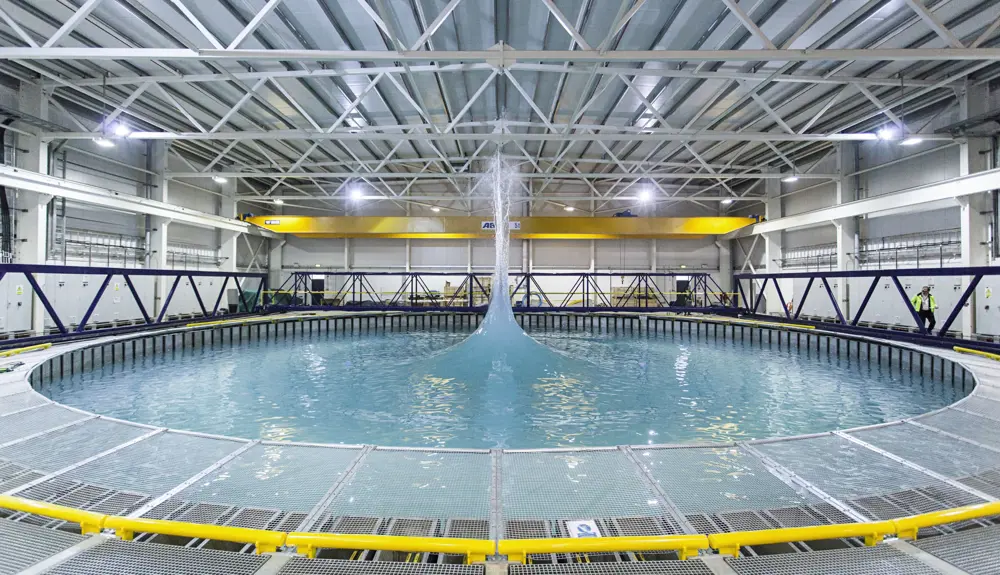
Testing in the FloWave pool is done over an area of more than 200 square metres, so depending on the scale chosen, this corresponds to full-scale seas with waves up to 28 metres, currents in excess of 12 knots, and a sea area of approximately two square kilometres © FloWave
Stuart Brown, CEO of FloWave, explains that when the tank tests tidal technologies, water at the top of the tank is pushed underneath its moveable floor, where there is more water, and the process then reversed to create a conveyor belt of water moving in one direction in the top tank and in the opposite direction in the bottom. Engineers testing the stability of tidal generators can therefore tether a model to the floor and analyse the water flowing past it, which simulates the velocity and turbulence of water at a real site. Previously, they would have had to rely on using a tow tank, hanging a turbine underneath a moving carriage in a rectangular tank. But this would not have taken turbulence into account, or what happens in real seas. By bottom mounting models, FloWave lets testers simulate how their turbine might cope with surface roughness, currents and turbulence at a lower cost in comparison to the costs of testing prototypes at sea.
For coastal and breakwater studies, the ability to absorb unwanted wave reflections has become more important, and has generally required that the wave makers are designed and built with longer stroke to give the paddle ‘room’ to absorb the longer wave components. Additional stroke is therefore particularly important when studying wave overtopping at coastal seawalls.
Creating tsunamis
Tsunami waves are of far longer duration than storm or swell waves, so a different class of wave maker is needed. In a bid to advance knowledge in this field, engineers at HR Wallingford in Oxfordshire have developed the largest specialist tsunami simulator in Europe, which can create two types of potentially destructive waves. It is being used to test coastal defences and urban environments for their tsunami resilience, which will ultimately lead to improved engineering guidance to aid disaster management worldwide.
The machine can replicate the shape and duration of two types of tsunami waves – those that are trough led and those that are crest led**. Professor William Allsop, Technical Director, Maritime Structures, at HR Wallingford, explains that tsunami waves approaching many coasts are usually trough led because of the way the Earth’s crust is bent during a subduction-zone earthquake, while those travelling into the middle of oceans tend to be crest led.
While in nature, subduction zone tsunamis are triggered by underwater earthquakes, the current simulator uses a pneumatic system and almost 70,000 litres of water to generate powerful tsunami waves with long duration. An air pump ‘sucks’ water from a test flume into the tsunami simulator tank to replicate the retreat of a trough-led tsunami, when water on a beach rushes out to sea before a huge crest wave races towards the coast, such as what happened in Thailand in 2004.

A cutaway of the tsunami simulator tank shows the exit and entry slot in the front face and flow shaper (left); a computer generation of the 70 metre-long fastflow facility at HR Wallingford (middle); an example test set-up for the HR Wallingford and UCL tests, showing measurement ‘buildings’ suspended from a force frame (right) © HR Wallingford
A complex computer system then opens the air-control valve to allow the water inside the tank to fall, generating the ‘elevated wave’ or crest of the tsunami. The ‘flow shaper’ at the tank outlet helps water leave it smoothly, allowing experts to control the wave as it makes its way down the test flume to the ‘test section’ where physical models mimic sea defence structures or buildings. This is what changes the shape of the wave.
Experts use a physical model because even the best CFD models cannot yet reproduce the full complexities of tsunami flows with representation of the correct turbulence over the shoreline and around defences or buildings. The results need to be robust if engineers are to trust the answers enough when designing buildings or new defences, but of course, creating and controlling realistic tsunami waves is not without its problems.
She has been able to observe how scaled tsunami waves interact with single buildings and come up with a formula to explain pressure distribution, which will be able to be used by engineers to estimate forces on buildings
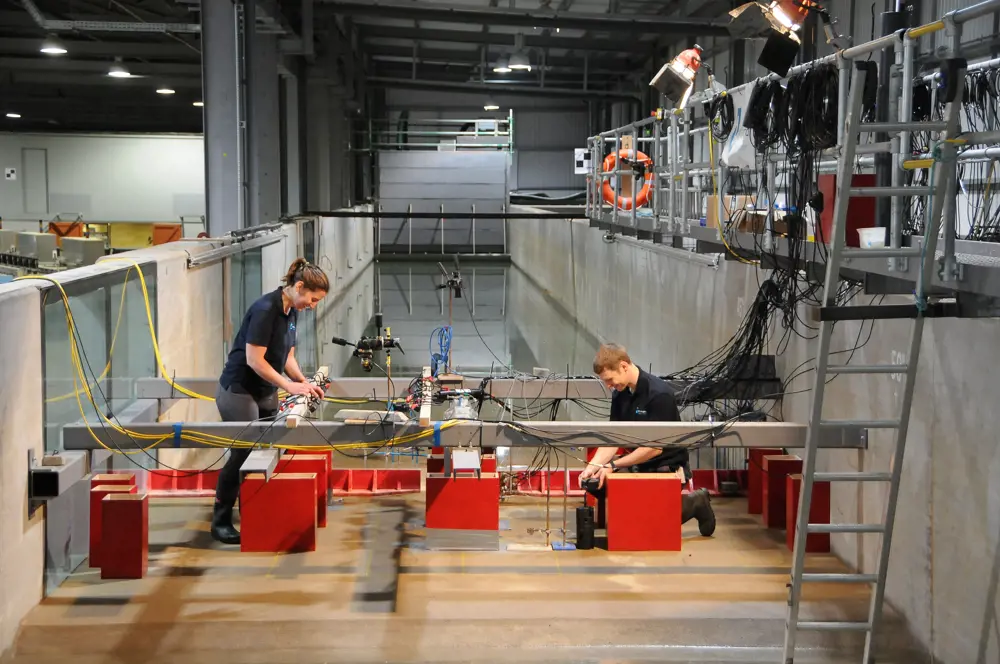
HR Wallingford’s fast-flow facility with the tsunami simulator at the far end and UCL’s measurements of tsunami forces on buildings in the foreground © HR Wallingford
One of the challenges faced when building the simulator was creating the kind of tsunami waves actually found at sea, including those of long duration. In response, HR Wallingford’s pneumatic system produces waves that are longer and more complex than solitary waves made by paddles. The pneumatic waves are also more controlled than those created using a ‘dam break approach’, piling up a column of water and letting it fall. With the tsunami simulator, waves can be transformed correctly to create a family of emergent waves, just the crest part of troughled waves, or the theoretical N-waves (an adaptation of a solitary wave that includes a trough, either trough leading or crest leading) used in some simulations.
Another challenge was creating an accurately scaled wave in the lab. Other technologies can simulate part or all of a tsunami wave but often produce a smaller-scale wave, meaning the results are subject to greater scale effects. However, the pneumatic system is able to generate stable trough waves of realistic durations at a scale of 1:50.
Solving these problems has allowed Tiziana Rossetto, Professor of Earthquake Engineering at UCL (University College London) and Director of its EPICentre, to generate the best possible data about tsunami waves for engineering use. She has been able to observe how scaled tsunami waves interact with single buildings and come up with a formula to explain pressure distribution, which will be able to be used by engineers to estimate forces on buildings.
Investigating and generating larger waves
Rising sea levels caused by global warming are making changes to wave and tidal patterns and could also make tsunamis even more devastating when they hit coastal communities, making this field of research more important than ever.
This means wave simulators designed to research wave and tidal interactions and probe the risks of giant waves will no doubt grow ever more realistic and generate useful data. Professor Allsop states that there is already wider and greater demand worldwide for more and better wave makers which will be developed as research budgets allow. Engineers at FloWave are already continuing to expand its instrumentation suite and will add new technical capabilities, such as replicating wind forces.
According to Jim Stewart at Murphy’s Waves, there is no limit to how big waves can be made; in the leisure industry, tanks can be made bigger and equipment adapted to create waves as large as water parks request.
With larger and longer waves possible and people’s appetite for extreme adventure increasing, it might not be long before we are surfing waves that are five metres tall and even higher.
***
This article has been adapted from "How to create the perfect wave", which originally appeared in the print edition of Ingenia 69 (December 2016).
Contributors
Sarah Griffiths
Author
Professor William Allsop is the Director of William Allsop Consulting Ltd. At the time of publication, he was Technical Director at HR Wallingford. He has more than 40 years’ experience of model testing of coastal structures. He was a Visiting Professor at the University of Southampton and an Honorary Professor at UCL.
Stuart Brown is the Founder and Director of Stuart Brown Consulting. At the time of publication, he was CEO of FloWave TT Ltd, the University of Edinburgh subsidiary company responsible for the FloWave Ocean Energy Research Facility. He began with the FloWave Project in early 2012 and led it through the construction and commissioning stages to the facility’s formal opening in August 2014.
Jim Stuart has been Managing Director of Murphy’s Waves since 2008. He has a degree in business management from Glasgow Caledonian University.
Keep up-to-date with Ingenia for free
SubscribeRelated content
Sports & leisure

Noise-cancelling headphones
Used by plane and train passengers wanting to listen to radio, music or film without hearing background noises, active noise-cancelling (ANC) headphones are able to prevent outside noise from leaking through to the inside of headphones.
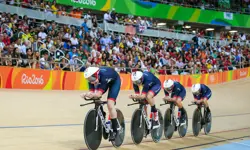
Going for gold
The success of Great Britain’s cycling team at the 2016 Rio Summer Olympic Games was celebrated, but what about the closely guarded technology that contributed to their success? The engineering approaches taken to shave as much time as possible off the clock are spoken about by Professor Tony Purnell.
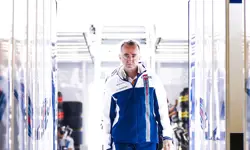
A formula for success
Over the past 30 years, Paddy Lowe FREng has seen Formula One motor racing grow from small teams to a billion pound enterprise at the forefront of technology. He has introduced active suspension, hybrid engines and other key technologies that have changed the profile of motor racing.
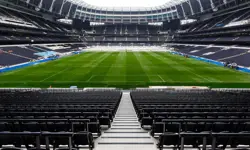
The football pitch in three pieces
Tottenham Hotspur Stadium is part of a regeneration project that has transformed the stadium and surrounding area. As well as being home to Tottenham Hotspur Football Club, the stadium will host NFL games in the UK and it boasts the world’s first dividing sliding pitch.
Other content from Ingenia
Quick read

- Environment & sustainability
- Opinion
A young engineer’s perspective on the good, the bad and the ugly of COP27

- Environment & sustainability
- Issue 95
How do we pay for net zero technologies?
Quick read

- Transport
- Mechanical
- How I got here
Electrifying trains and STEMAZING outreach

- Civil & structural
- Environment & sustainability
- Issue 95